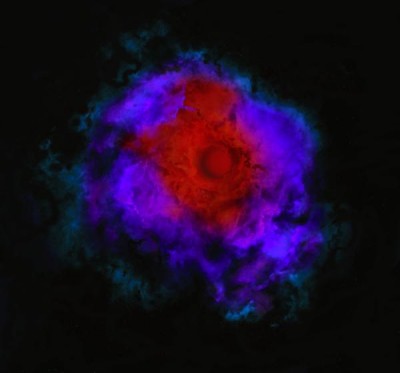
Annihilation of dark matter may have prevented fusion igniting the first stars, leaving them as huge orbs of faintly glowing hydrogen and helium, claim physicists in the US. Such “dark stars”, which have not yet been observed, could explain why black holes formed so quickly after the Big Bang — although their existence could force physicists to rethink how the early universe evolved.
Dark matter was originally put forward to explain how galaxies manage to hold themselves together, given that they appear to have just a small fraction of the mass needed to produce enough attractive gravity. Although no-one knows what dark matter is, cosmologists think it also played a big role in the early universe, helping hydrogen and helium atoms to clump together until they were dense enough to begin fusing and form the first stars.
Now, Paolo Gondolo from the University of Utah, together with colleagues from elsewhere in the US, says that interactions within dark matter itself could have hindered star formation. The researchers modelled star formation involving the neutralino, a particle predicted by the popular “supersymmetric” extension to the Standard Model of particle physics and a favoured candidate to comprise dark matter.
Neutralinos are believed to annihilate occasionally and produce heat, but Gondolo’s group has calculated that a primordial clump of hydrogen and helium would trap this heat in its core, keeping the clump from compacting and thus stemming fusion. The resultant dark star could grow up to 2,000 AU in diameter — 200,000 times that of our Sun — while glowing with infrared radiation (Phys. Rev. Lett. in publication; preprint available at arXiv:0709.2369).
Clumping matter
The researchers began modelling the star formation with an existing simulation of how hydrogen and helium gas contract into clumps, supplementing it with a new simulation of how neutralino dark matter contracts under the gas’s gravitational pull. They then calculated how the heat produced by neutralino annihilation would balance with the heat lost through cooling, and found there was a critical density beyond which the cooling is outweighed by the heating.
Gondolo’s group are not sure how long a dark star produced by this mechanism would last, because even if the dark matter is depleted by annihilation it could be replenished again. Even so, the existence of dark stars could have several consequences. They could explain why supermassive black holes, which are thought to be produced over billions of years in star clusters, appear to have been present a few hundred million years after the Big Bang. A dark star might attract enough surrounding gas so that inward pressure gets greater and greater, until it is finally overwhelmed and collapses into one of these black holes.
Unfortunately, dark stars might also spoil cosmologist’s understanding of reionization, when ultraviolet photons from the first stars stripped electrons from neutral hydrogen. If some or all of these first stars were dark, the source of the reionization would have to come from somewhere else. Moreover, lacking fusion, dark stars would not be able to generate the elements heavier than hydrogen and helium we see today.
Gamma ray evidence
In principle, dark stars could be detected by looking for the signature by-products of annihilation, such as gamma rays, which do not normally come from regions of hydrogen and helium gas. But even though observational evidence is currently lacking, Tom Theuns, a computational cosmologist from the University of Durham in the UK, told physicsworld.com that he thought the idea of having very different first stars is interesting. “But how this affects other things, for example the amount of metals these stars produce, their supernova or gamma-ray burst properties, [or] how this affects later generations of star formation…these issues need still to be worked out,” he added.




